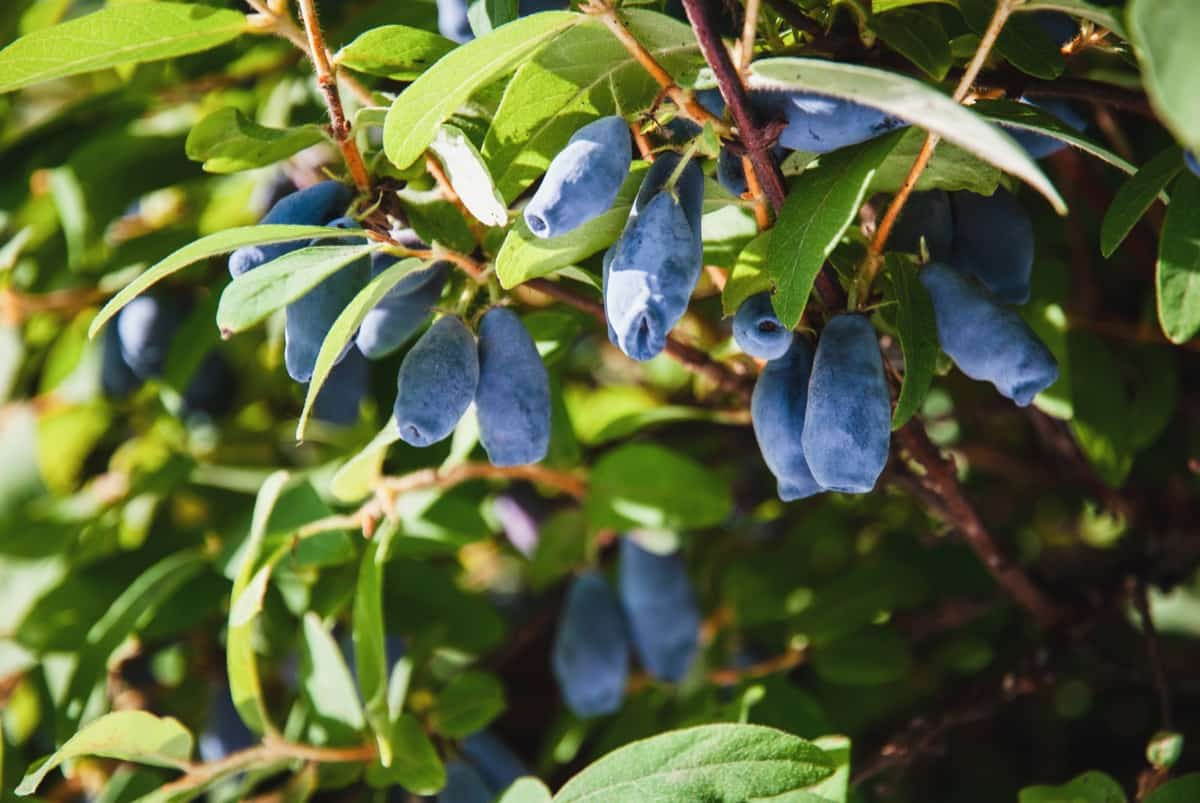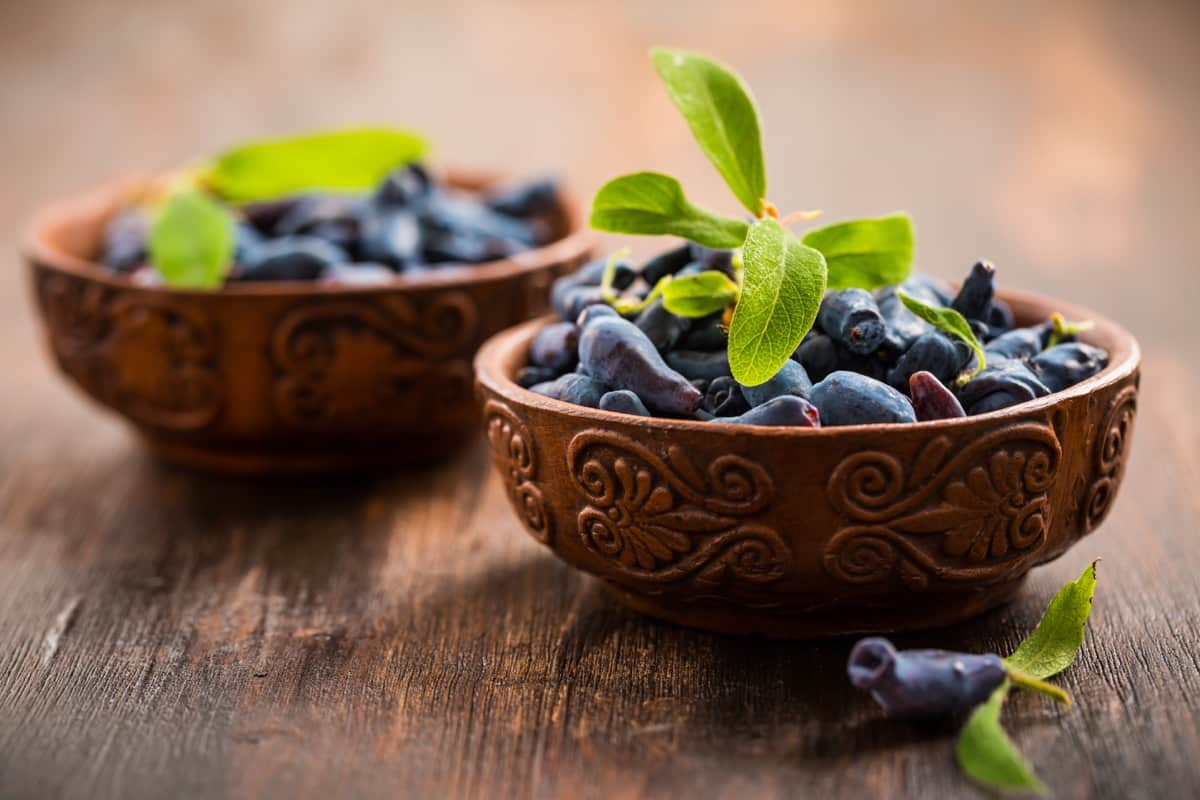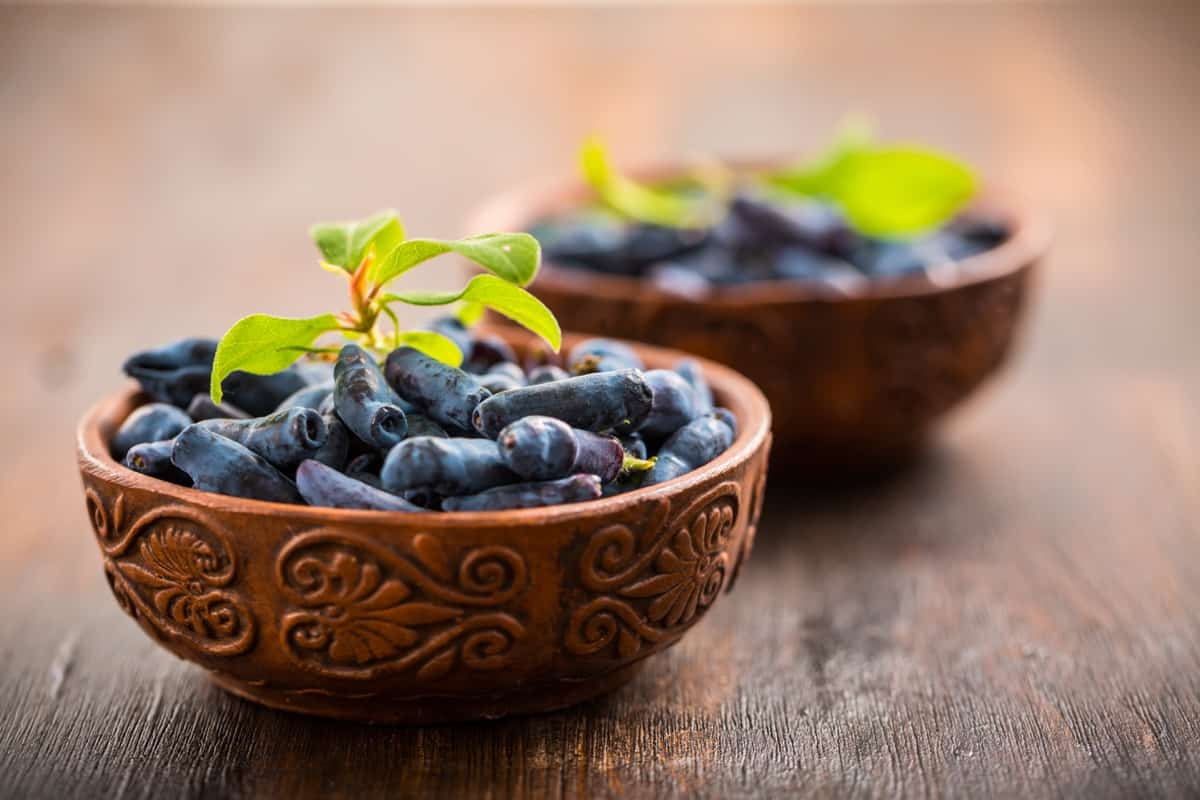Honeyberries are a delicious, nutrient-rich fruit that can be grown in most home gardens. Though they are technically a berry, Honeyberries resemble miniature blueberries in appearance and taste. Honeyberries are a type of edible berry that can be found in many different colors, including blue, purple, and black. These berries are not only delicious but also offer a variety of health benefits. Let’s check out how to grow and care for Honeyberries in your garden below.

Honeyberries are a perfect option if you’re looking to add more fruit to your diet. There are many different Honeyberry plants, each with its unique flavor. While some Honeyberries are tart and acidic, others are sweet and delicious. Regardless of the type of Honeyberry plant, they all provide a healthy dose of antioxidants, vitamins, and minerals. Growing and caring for Honeyberries in your garden can be a rewarding experience.
Properly caring for these bushes will ensure you have delicious berries each year. It is important to remember that Honeyberries are a hardy plant, but they still require regular pruning to stay healthy and produce the most flavorful fruit possible. With their unique flavor and nutritional benefits, there’s no doubt why Honeyberry plants are becoming increasingly popular among home gardeners.
How to Grow and Care for Honeyberries in Your Garden
Types of Honeyberry Plants
Jugana – Jugana is a Honeyberry plant that produces small, round fruits. The fruit’s skin is thin and delicate, and the flesh is sweet and juicy. Jugana plants thrive in sunny, well-drained areas and can reach up to 6 feet tall. These berries can be eaten fresh or used to make jams, jellies, or syrups.
In case you missed it: How to Grow Raspberries from Seed to Harvest: Check How this Guide Helps Beginners

Indigo Gem – Indigo Gem is a variety of Honeyberry plants known for their large, dark blue berries. Indigo Gem plants are fairly easy to grow and produce much fruit. Indigo Gem is a variety of Honeyberries known for its intensely sweet flavor. These berries are dark blue and have a jelly-like texture.
Aurora – Aurora is a Honeyberry plant that produces small, sweet berries. The plants are relatively easy to care for and can be grown in most climates. There are many different types of Honeyberry plants, each with unique characteristics. This variety is known for its large, glossy berries with a sweet flavor and hints of citrus.
Boreal Blizzard – This variety can withstand lower temperatures, making it one of the hardiest Honeyberry plants. The Boreal Blizzard produces large, delicious berries for making jams and jellies. If you’re looking for a berry plant that can withstand cold temperatures, look no further than the boreal blizzard. The boreal blizzard is a large shrub that produces dark blue berries that are delicious and nutritious.
Kawai – Kawai Honeyberry plants are deciduous shrub that grows 3-5 feet tall and wide. The leaves are oblong-shaped and have serrated edges. The flowers are small, white, and fragrant. The fruits are black, blue, or red berries about the size of a blueberry.
Blue Banana – There are many Honeyberry plants, but the blue banana variety is among the most popular. This variety is known for its large, deep blue berries with a sweet honey flavor. The blue banana plant is a vigorous grower and produces abundant fruit.
Tana – Tana is a deciduous shrub that grows to about 6 feet tall. It has alternate, simple leaves that are obovate in shape and measure 2-4 inches long. The margins of the leaves are serrated. The flowers of the tana Honeyberry plant are small, white, and borne in clusters of 5-10. They have a mild, pleasant aroma and bloom from May to June. The fruits of the tana Honeyberry are oval-shaped and measure about 1 inch long.
In case you missed it: Growing Strawberries from Seed to Harvest: A Complete Planting Guide for Beginners

Climate Suitable for Growing Honeyberries in the Garden
When selecting a site for planting Honeyberries, choose an area that receives full sun during the day. The plants will also need some protection from strong winds. Honeyberries prefer well-drained soil that is high in organic matter. You can add compost or peat moss if it is heavy. Honeyberries are perfect for growing in gardens because they don’t require much sun to thrive.
Too much sun can harm Honeyberries, so choosing a spot in your garden that receives partial sun or filtered sunlight is important. If you live in an area with very hot summers, it’s best to grow Honeyberries in a shaded spot to protect them from the intense heat.
Soil Requirement for Growing Honeyberries in The Garden
If you want to add Honeyberries to your garden, ensure you have the right soil. Honeyberries prefer soil that is acidic, well-drained, and rich in organic matter. You can do this by amending your soil with compost or peat moss. It’s also best to test your soil’s pH level before planting to ensure it’s in the right range for Honeyberries.
The best soil for growing Honeyberries in your garden is rich, loamy soil with a pH between 6.0 and 7.5. Honeyberries tolerate most soil types but prefer well-drained soil high in organic matter. You should also ensure the planting site receives full sun for at least six hours daily.
Water Requirement for Growing Honeyberries in The Garden
Water is an important part of growing Honeyberries in your garden. The plants need 1-2 inches of water per week from rainfall or irrigation. If you use a soaker hose, lay it on the ground next to the plants and turn it on for about 30 minutes once a week. Water early in the day so the leaves have time to dry before nightfall.
In case you missed it: How to Plant Blueberries from Seeds: A Beginners Guide to Sowing to Harvest

Honeyberries are heat and drought-tolerant once established, so if you live in an area with little rainfall, you may need to supplement with irrigation. Check the soil moisture before watering Honeyberries; dislike wet feet. If your plants are in containers, they must be watered more frequently.
Propagating Honeyberries
From Cuttings
Honeyberries are best propagated by softwood or hardwood cuttings. Hardwood cuttings should be taken from one-year-old wood in late fall or early winter, while softwood cuttings can be taken in spring. Choose a healthy stem and cut it into 6-8-inch sections to take a hardwood cutting. Each section should have 2-3 buds. Remove the bottom leaves of each cutting, dip the ends in rooting hormone, and plant them in a pot. Place the pot in a plastic bag to create a humid environment, and keep the cuttings at 15-21°C. The cuttings should root within 4-8 weeks.
Honeyberry Plant Care
Fertilizer Requirement for Growing Honeyberries in the Garden
Honeyberries are a unique and delicious fruit that can be a great addition to your garden. While they are relatively easy to grow, you must know a few things to ensure a bountiful harvest. One of the most important things is understanding the fertilizer requirements for growing Honeyberries. Unlike other fruits and vegetables, Honeyberries have very specific nutrient needs. To produce large, healthy fruits, you must use a fertilizer with high nitrogen, phosphorus, and potassium levels.
You should also ensure that your chosen fertilizer is designed for acid-loving plants, as Honeyberries thrive in slightly acidic soils. When applying fertilizer to your Honeyberry plants, it is important to do so carefully. Over-fertilizing can damage the roots and lead to poor fruit production. It is best to apply fertilizer around the plant’s drip line (where rainwater would naturally fall), being careful not to get any on the leaves or stems. Apply fertilizer once every two weeks during the growing season, and reduce the frequency to once monthly during winter.
In case you missed it: Growing Strawberries from Seed to Harvest: A Complete Planting Guide for Beginners

Pruning Honeyberry Plants
Pruning Honeyberry plants is an important part of their care. Pruning helps to encourage new growth and keeps the plant healthy. When pruning, it is essential to remove any dead or damaged branches. It is also important to thin out the plant so that air can circulate and sunlight can reach all parts of the plant. Pruning your Honeyberries is an important part of taking care of them. You should prune them in the early spring before they start to grow. You can prune them with shears or a sharp knife.
Start by cutting any dead or diseased branches. Then, cut back any branches that are growing too close together. This will help the air circulate better and prevent disease. Finally, cut back any branches that are longer than about 3 feet. Pruning your Honeyberries will help them stay healthy and produce more fruit.
Honeyberry Plant Care in Winter
Although Honeyberries are fairly low maintenance and can tolerate various growing conditions, you can do a few things to give them extra care in winter. First, make sure they are well-watered going into winter. Honeyberries are deciduous plants, meaning they will lose their leaves in winter, but the roots will continue to grow. They will need moisture to help them through this dormant period.
Second, you can apply a layer of mulch around the base of the plant. A thick layer of straw or bark chips works well. Finally, if you live in a very cold area in winter, you may consider covering your plants with burlap or fabric to provide extra protection from the elements. Be sure to remove any covers in early spring so that the plants can get some sunlight and air circulation.
Pests and Diseases of Honeyberry Plant and their Control
Pests of Honeyberry plants include aphids, mites, and scale insects. These pests can be controlled with various biological and mechanical methods. Aphids feed on the sap of plants. They can be controlled with several biological controls, including ladybugs and lacewings. Mechanical controls include pruning infested branches and spraying the plants with water. Mites are tiny creatures that feed on the leaves of plants.
They can be controlled with several biological controls, including predatory mites and spiders. Mechanical controls include spraying the plants with water and pruning infested branches. Scale insects are small, hard-bodied insects that feed on the sap of plants. They can be controlled with several biological controls, including parasitic wasps and ladybugs. Mechanical controls include pruning infested branches and spraying the plants with water.
In case you missed it: 9 Best Berries to Grow in Containers: Well Explained in Simple Steps

Honeyberry plants are susceptible to several diseases, including gray mold and powdery mildew. Other Honeyberry diseases include root rot, bud blast, and crown gall. To control diseases of Honeyberry plants, it is important to choose disease-resistant varieties and to practice good cultural methods of plant care, such as proper spacing, pruning, and irrigation. If a plant becomes infected with a disease, prompt treatment with the appropriate fungicide or other pesticide is essential for preventing the spread of the disease to other plants.
Conclusion
Honeyberries are a unique and delicious fruit that can be grown in your garden with a little care and attention. They are a great addition to any landscape, and with proper care, they will produce abundant fruit for many years. While some Honeyberry plants are used for their edible fruit, others are grown for their attractive flowers or fragrant leaves.
You’ll surely add a delicious touch to your home garden no matter what type of Honeyberry plant you choose. There are many different Honeyberry plants, each with unique flavor and characteristics. With so many delicious options, finding the perfect Honeyberry plant for your needs is easy.
- Where to Place Indoor Plants in Your Home
- How to Grow Tomatoes Organically at Home: A Comprehensive Guide
- Organic Gardening on a Budget: Low-Cost Methods and Materials
- Gongura Seed Germination and Planting Methods
- Cabbage Seed Germination and Selection
- Broccoli Seed Germination and Selection
- Asparagus Seed Germination and Variety Selection
- Seasonal Flower Gardening: Best Practices for Spring, Summer, Fall, and Winter
- How to Grow Hibiscus from Flower
- Plantation Ideas for Home Decoration: A Beginners Guide
- Flower Garden Designs and Layouts for Beginners
- Planting and Spacing Techniques in Papaya: A Beginner’s Guide
- Growing Gold: Essential Techniques for Planting Pineapples
- How to Make Kalanchoe Plant Bushy: Home Remedies and Solutions
- 11 Reasons Why Your Gardenia is Not Blooming: Home Remedies and Solutions
- Eco Elegance: The Guide to Designing a Drought-Tolerant Landscape
- Gardening on a Slope: Strategies for Hillside Landscaping
- Nourish and Flourish: Top Organic Mulches for Thriving House Plants
- Everything You Want to Know about Indian Mogra Flower: Discover Uses and Growing
- Green Thumb Success: Expert Tips for Cultivating Greenhouse Pumpkins All Year Round
- Maximize Growth & Flavor: The Ultimate Guide to Companion Planting in Herb Gardens
- How to Control Rhododendron Problems Naturally: Home Remedies and Organic Ways to Fix Them
- Natural Magic: The Remarkable Benefits of Cinnamon for Plants
- Best Steps to Revive Dying Tulip with Natural and Organic Treatment
- 10 Reasons Why Your Angel Trumpet is Not Blooming: Remedies and Treatment
- How to Fix Periwinkle Leaf and Flower-Related Problems: Natural Remedies and Solutions
- How to Fix Zinnias Leaf and Flower Problems: Discover Natural and Home Remedies
- Organic Steps to Induce Lemon Tree Flowers: A Comprehensive Guide
- Bloom Booster: Crafting the Perfect Homemade Bougainvillea Fertilizer
- Optimizing Growth: A Guide to Applying NPK Fertilizer for Potted Plants
- 10 Best Homemade Fertilizers for Rubber Plant: DIY Recipes and Application Method
- How to Boost Female Pumpkin Flowers: Effective Steps for More Flowers and High Yields
- Transform Your Indoor Garden: Top Benefits of Pink Salt for Houseplants
- 10 Best Homemade Fertilizers for Peacock Plants (Calathea): Easy DIY Guide
- Unlock Blooms: 9 Reasons Why Your Potted Chrysanthemum is Not Blooming
- 8 Reasons Why Your Potted Hibiscus is Not Blooming: Fix it with Simple Solutions